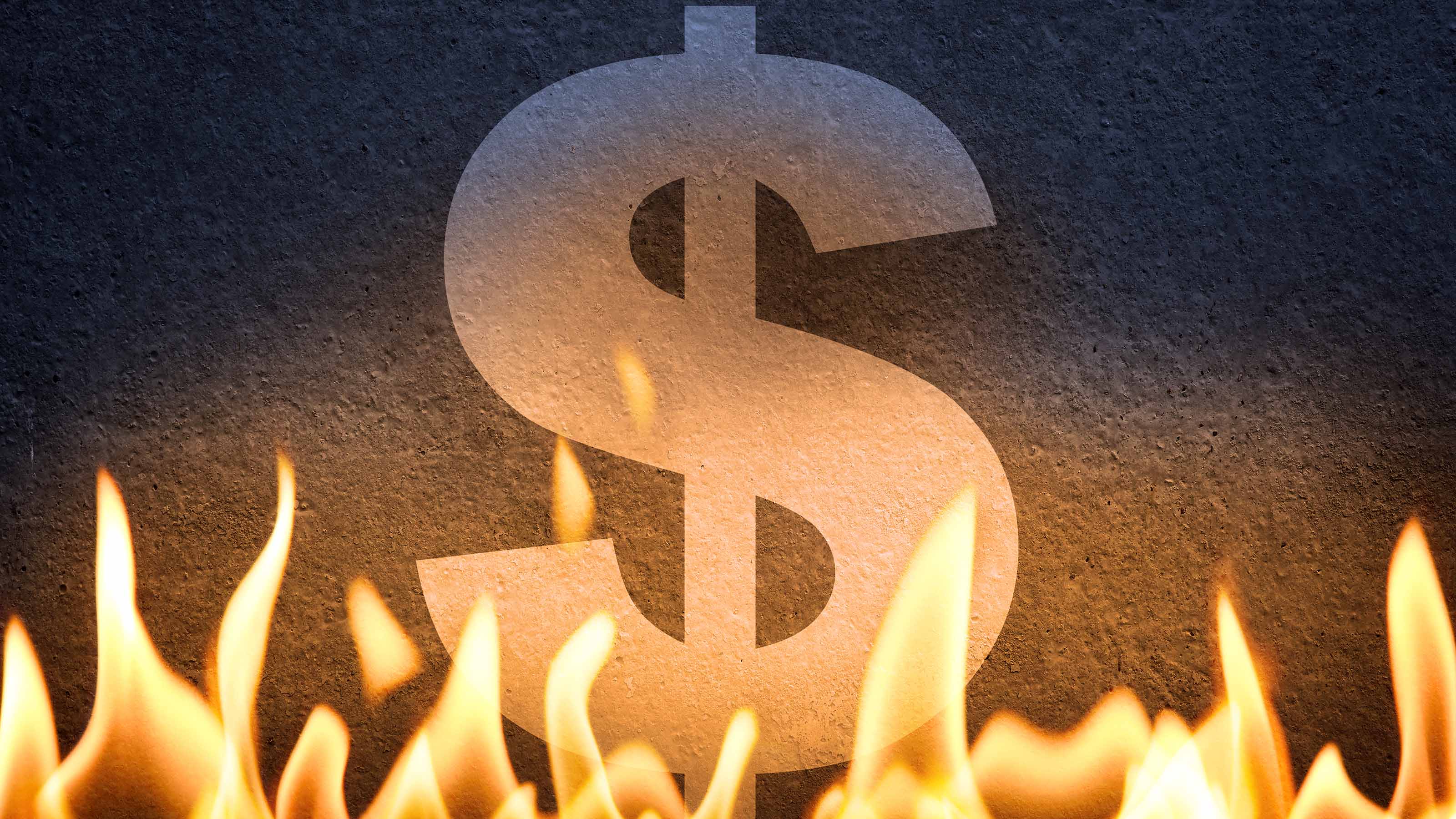December CPI Report: What the Experts Are Saying About Inflation
A hotter-than-expected CPI report means the Fed won't be cutting interest rates as aggressively as hoped, experts say.


Market participants had to temper their expectations for rate cuts after the Consumer Price Index (CPI) revealed that inflation unexpectedly accelerated at the end of 2023.
Headline inflation rose 3.4% on an annual basis in December, the Bureau of Labor Statistics reported Thursday, up from 3.1% the previous month. That was the biggest gain in three months and easily topped economists' forecast for inflation to increase 3.2% in December. On a monthly basis, December inflation rose 0.3% vs expectations for a 0.2% increase.
Core inflation, which excludes volatile food and energy costs and is considered to be a better predictor of future prices, rose 0.3% in December. That matched the prior month's reading and was in line with forecasts. On an annual basis, core inflation hit 3.9% in the final month of 2023, or the lowest level since the second quarter of 2021.
From just $107.88 $24.99 for Kiplinger Personal Finance
Become a smarter, better informed investor. Subscribe from just $107.88 $24.99, plus get up to 4 Special Issues

Sign up for Kiplinger’s Free Newsletters
Profit and prosper with the best of expert advice on investing, taxes, retirement, personal finance and more - straight to your e-mail.
Profit and prosper with the best of expert advice - straight to your e-mail.
The goods and services driving the upside surprise in inflation were found in the shelter, energy and food components of the price index.
Markets rallied hard into the end of last year on expectations that the Federal Reserve would pivot to interest rate cuts in 2024, perhaps as soon as the Fed meeting in March. Suffice to say the hotter-than-expected inflation print complicates those forecasts.
With the December CPI report now a matter of record, we turned to economists, strategists and other experts for their thoughts on what the data means for markets, macroeconomics and monetary policy going forward. Please see a selection of their commentary, sometimes edited for brevity or clarity, below.
Expert takes on the CPI report

"Today's CPI report is a reminder that inflation, while improving, is not vanquished. Trends towards lower inflation, for the most part, remain intact but it would seem a path of rate reductions closer to the Fed forecast, currently at three this year, makes more sense than the market's more aggressive stance. It may be the Fed can begin dialing back rates a bit in March, but the outlook for cuts sooner than that took a hit with today's slightly hotter CPI report. The trend in inflation remains lower, but it will not go quietly. The Fed's more patient approach, as reflected in their updated dot plot, seems more reasonable than the market's expectations of around six rate cuts." – Steve Wyett, chief investment strategist at BOK Financial
"The CPI report is not a game changer for the Fed, which is widely expected to remain on the sidelines at its next policy meeting at the end of the month. But the report also was not that comforting to a market that is looking for a first-quarter rate cut. It is probably discouraging enough to keep the Fed on hold longer than the market currently expects. We need to see more capitulation in services and shelter inflation before we can sound the all clear on the inflation mandate." – Scott Anderson, chief U.S. economist at BMO Capital Markets
"The December uptick in the CPI was to a large degree driven by meaningful increases in used vehicle prices and the heavily weighted rent of shelter that accounts for over 40% of the CPI. Both used vehicle prices and rents are widely expected to come back down over the next handful of months and the uptick in CPI should not be cause for alarm. The trends that have defined declining inflation pressures have been clear for some time and by some metrics the war on inflation has already been won. The Fed is arguably no longer worried about the possibility of runaway inflation, which is more or less the same as to say the Fed is no longer worried about inflation, despite the uptick in December." – Johan Grahn, head of ETF strategy at AllianzIM
"December core CPI rose 0.31% compared to +0.28% in November. The year-on-year rate fell one tenth to 3.9%. The composition was mixed, as shelter measures slowed, but the medical and car insurance categories accelerated as prices catch up to the post-pandemic cost environment. New and used car prices were surprisingly strong, clouding the short-term outlook for disinflation in that sector but consistent with eventual large declines later in 2024." – Jan Hatzius chief economist at Goldman Sachs
"The CPI and core CPI came in slightly higher than expected. We do not expect these numbers to have an impact on the Fed in the near term. However, we believe that this will reduce the odds of the six rate cuts that the market has priced into the market. The Fed has pushed back from market pricing and this should bring market expectations more in line with Fed expectations. The core CPI is now below 4%, which is the lowest it has been since the second quarter of 2021. We believe that the inflation rate will continue to decline toward the Fed goal of 2% over the next several months. Lagging indicators like rents will likely drive down the CPI in the next few quarters. Despite the recent pullback, we expect the upward trend in the market to continue into next year with small cap stocks leading large cap stocks in 2024." – Eric Green, chief investment officer at Penn Capital Management
"Core inflation, a reliable predictor of future headline inflation, remained unchanged in December and slightly declined compared to a year ago. This, coupled with reduction in underlying price pressures, indicates that we may be approaching the Federal's Reserve's inflation target this year, despite a slight increase in headline inflation. A soft landing for the economy is increasingly likely, as unemployment stays low and prices head In the right direction." – Dawit Kebede, senior economist at America's Credit Union
"The final CPI report of 2023 offered few surprises. Headline CPI rose 0.3% in December, a touch more than consensus expectations and driven by slightly stronger energy price growth in the month. Core CPI also increased 0.3%, in this case matching the consensus forecast. Core goods prices were unchanged in December, and on a year-over-year basis inflation in this category is little different than its pre-COVID trend. Core services inflation, however, has remained somewhat stickier, with shelter prices easing only slowly and travel-related prices rebounding somewhat in December. We look for inflation to slow further over 2024 amid improved supply dynamics and more tepid demand from consumers. However, progress is likely to be slower-going this year and keep policymakers uneasy about how quickly inflation can return to 2% on a sustained basis." – Sarah House, senior economist at Wells Fargo Economics
"CPI inflation in December was a bit higher than forecasters expected. The headline CPI rose 0.3% in December, up from 0.1% in November, while the core CPI rose 0.3%, unchanged from November. On a year-over-year basis, headline and core inflation were 3.4% and 3.9%, respectively. These numbers are not especially surprising, and they're unlikely to prompt the Fed to cut the federal funds rate later this month, which some observers had been hoping for." – Patrick Horan, macroeconomist at the Mercatus Center
"CPI should remain on a downward trajectory this year, but this slight backup serves as a healthy reminder that imminent rate cuts shouldn't be taken for granted. With markets buoyed by financial conditions loosening at a historically rapid rate over the last couple months, there is room to absorb some disappointment in this print and look forward to more progress on the inflation battle next month. However, with so much of the recent market optimism predicated on expectations of goldilocks rate cuts, investors are wise to expect disproportionately negative reactions to continued CPI stubbornness." – Adam Hetts, global head of multi-asset and portfolio manager at Janus Henderson Investors
"The tug of war between the Fed and the markets looks poised to continue as the market-implied path for the fed-funds rate remains well below the Fed's most recent projections following today's CPI inflation report. Both headline and core prices came in at or above consensus for the month, while the year-over-year numbers came in higher than consensus. Fed-funds futures are pricing between five and six rate cuts in 2024, whereas the FOMC's most recent projections forecast just three rate cuts. There's reason to believe the shelter component of inflation should start to weaken, but in the absence of an economic slump or substantial disinflation during the coming months, we may see Treasury yields continue to drift higher as markets curtail their expectations for the easing of monetary policy." – Austin Schaul, head of research at Avantax
"This morning's data may somewhat reduce the likelihood of early Fed rate cuts; however, both the Fed and the markets knew inflation wouldn't moderate in a straight line. Core inflation is indicating the overall trend of moderating inflation remains intact. Today's headline inflation data came in modestly higher than last month and higher than expected, both on a month-over-month and year-over-year basis. Shelter and energy costs were the biggest drivers of the increase. This marks the first time y/y core inflation has been below 4% since inflation began accelerating in 2021." – David Royal, chief financial and investment officer at Thrivent
"Today's inflation data is a disappointment for the bulls but it may not have the biggest impact because attention will soon turn to quarterly earnings. Few things in the stock market or economy move in a straight line, so investors may look past this high inflation reading given the Fed's softer language recently. It's not great news for stocks, but it might not be fatal either." – David Russell, global head of market strategy at TradeStation
"Today's inflation report reaffirms our view that the Fed will likely focus more on growth and employment trends, not inflation, in 2024. Inflation has cooled considerably, supporting their policy stance to pause, but has not cooled sufficiently for the Fed to consider cutting rates aggressively. Core inflation matched expectations, although housing-related inflation was a tad hotter than expected, suggesting demand for residential real estate is persisting. Also released this morning were weekly figures on unemployment claims. These figures remained subdued, providing evidence that the labor market is still healthy – pointing to a Fed pause on interest rates, and not a rash of cuts in the near-term." – George Mateyo, chief investment officer at Key Private Bank
"Consumer prices increased more than expected during the last month of the year, both month over month as well as year over year as shelter prices continued to defy expectations of weakness. Year over year headline CPI inflation remained unchanged during the second half of 2023, while core CPI inflation has continued to disinflate but at a slower pace than during the first half of 2023. We still expect the pace of disinflation to accelerate after March as base effects start to disappear. However, the higher than expected shelter price increase is not good news for the markets and for the Federal Reserve. These factors continue to point to the need for 'high for longer' interest rates, even as the Fed's December tone was more dovish than expected." – Eugenio Alemán, chief economist at Raymond James
Related Content
Profit and prosper with the best of Kiplinger's advice on investing, taxes, retirement, personal finance and much more. Delivered daily. Enter your email in the box and click Sign Me Up.

Dan Burrows is Kiplinger's senior investing writer, having joined the publication full time in 2016.
A long-time financial journalist, Dan is a veteran of MarketWatch, CBS MoneyWatch, SmartMoney, InvestorPlace, DailyFinance and other tier 1 national publications. He has written for The Wall Street Journal, Bloomberg and Consumer Reports and his stories have appeared in the New York Daily News, the San Jose Mercury News and Investor's Business Daily, among many other outlets. As a senior writer at AOL's DailyFinance, Dan reported market news from the floor of the New York Stock Exchange.
Once upon a time – before his days as a financial reporter and assistant financial editor at legendary fashion trade paper Women's Wear Daily – Dan worked for Spy magazine, scribbled away at Time Inc. and contributed to Maxim magazine back when lad mags were a thing. He's also written for Esquire magazine's Dubious Achievements Awards.
In his current role at Kiplinger, Dan writes about markets and macroeconomics.
Dan holds a bachelor's degree from Oberlin College and a master's degree from Columbia University.
Disclosure: Dan does not trade individual stocks or securities. He is eternally long the U.S equity market, primarily through tax-advantaged accounts.
-
 'Humbug!' Say Consumers, Despite Hot GDP: Stock Market Today
'Humbug!' Say Consumers, Despite Hot GDP: Stock Market Today"The stock market is not the economy," they say, but both things are up. Yet one survey says people are still feeling down in the middle of this complex season.
-
 The SEC Is Concerned for Older Investors and Retirement Savers. Here's What You Should Know
The SEC Is Concerned for Older Investors and Retirement Savers. Here's What You Should KnowThe SEC focusing on older investors, retirement and college savers, and private securities. Here's how those changes impact you.
-
 Vesting, Catch-Ups and Roths: The 401(k) Knowledge Quiz
Vesting, Catch-Ups and Roths: The 401(k) Knowledge QuizQuiz Test your understanding of key 401(k) concepts with our quick quiz.